|
The Main Injector is the fourth accelerator in the Fermi chain of accelerators, but this is somewhat of an arbitrary designation. It gets its protons from the Proton Source, which is made up of the Linac and the Booster. The beam begins and gets its first acceleration in the Preaccelerator, from there it gets two more RF boosts: first from the Drift Tubes, located in the front part of Linac, and next from the Side-Coupled Cavities, located in the middle of Linac, and then it goes on to the Booster.
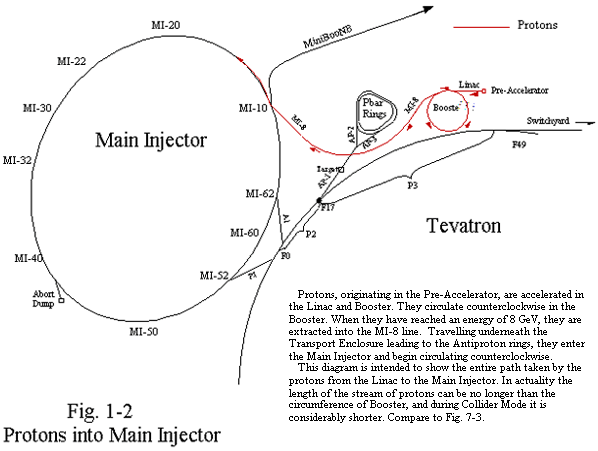
The Main Injector Role
The most interesting part of the Main Injector is how many different jobs, or "modes of operations," it has. Transport lines connect the Main Injector to the Tevatron, to the Booster, the Antiproton Source, Switchyard, and finally the Recycler Ring. In addition, NuMI beam will come from the Main Injector MI-60 area and MiniBooNE beam passes through a portion of MI tunnel at MI-10. The Main Injector is the link between all of these machines. The Main Injector can accelerate or decelerate particles between the energies of 8 GeV and 150 GeV. The sources of the particles and their final destinations depend on the "mode of operation."
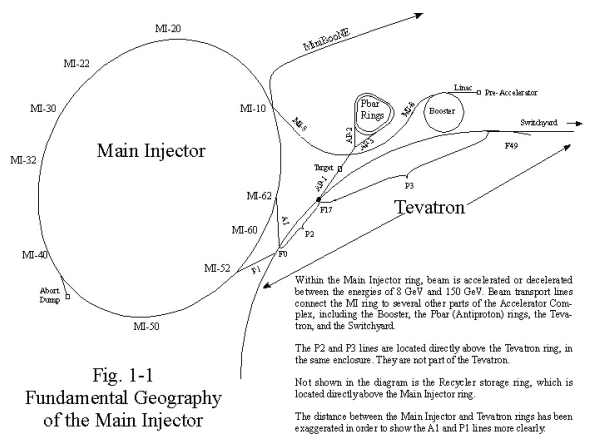
Transport Lines
Beam transport lines connect the different machines to the Main Injector: the MI-8 line transports 8 GeV protons from Booster to the Main Injector, protons leaving the Main Injector use the P1 line, antiprotons use the A1 line, and both lines terminate at the F0 sector of the Tevatron. R22 and R32 connects MI to the Recycler. The P2 and P3 lines are located in Tevatron's F sector. F sector links Main Injector to Switchyard in one mode, and to the Antiproton Source in another. The TeV's F17 sector is where the beam line to the Antiproton Source branches off.
Antiproton Production
One of the Main Injector's most common task is providing beam to the antiproton production target. The Main Injector receives a single batch of 8 GeV protons from Booster, accelerates the protons to 120 GeV, and then sends them to the Pbar target, which yields 8 GeV antiprotons. A clock event controls this and all other modes of operation. These clock events come from the Time Line Generator (TLG). When it is time for the beam to leave MI and make antiprotons, extraction devices push the entire batch out of the ring and into the P1 line. From there, the protons go to the P2 line, the AP-1 line, and then to the antiproton target. The entire 120 GeV antiproton production cycle takes about 2 seconds. To make as many antiprotons as possible, the target is continuously bombarded at the fastest possible rate.
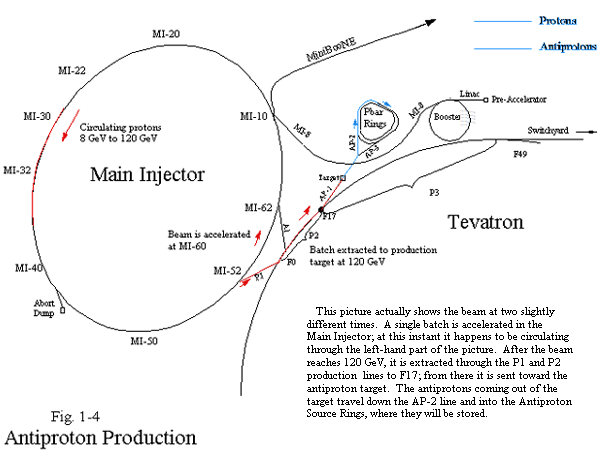
Fixed Target Modes
During Fixed Target operations, protons are accelerated to the desired energy and then extracted to a stationary target external to the ring. Extraction takes place from the Main Injector at 120 GeV. The fixed target can be anything from metal to a flask of liquid hydrogen.
Extraction starts with 8 GeV beam from the Booster, using six full batches, which is all that the Main Injector can comfortably hold. MI accelerates the six batches to 120 GeV. The beam "spills" out of the machine over an enormously long time-say, two seconds-as opposed to being kicked out in a few microseconds as is the case with other modes of operation. The beam passes through the P1 line to the P2 line to the P3 line, and finally into Switchyard. Spill that takes a couple of seconds is considered "slow spill." There is also "fast spill," usually required by neutrino experiments, which occurs over a period of a few milliseconds. One of the experiments that will use fast spill is NuMI.
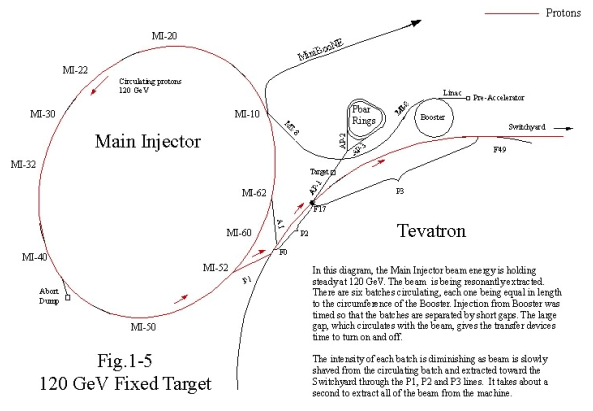
MiniBooNE
MiniBooNE beam is extracted from the Booster and sent down the MI-8 line, but just as it reaches the Main Injector ring, it is sent north toward the experiment.
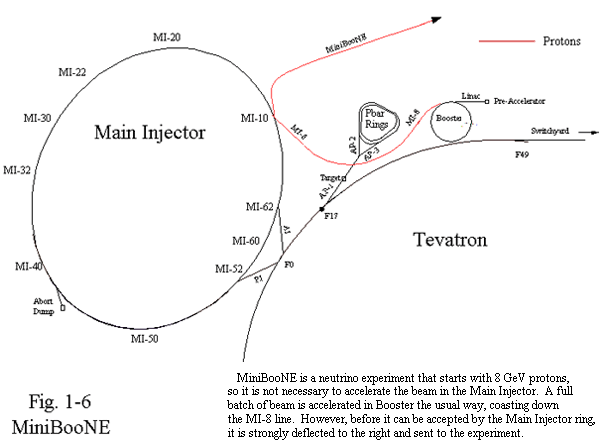
Collider Operations
The most complex mode of operation is the Collider Mode. Protons circulating clockwise in the Tevatron collide with antiprotons that are circulating counterclockwise. They collide at two large experiments that hang like parasites around the Tevatron beam pipe. The Main Injector plays many roles in this mode. It supplies protons for antiproton production. It accelerates the protons and antiprotons to 150 GeV before sending them to the Tevatron. However, the experiments need "superbunches," which are more intense than any normal bunch. The Main Injector uses a process called coalescing to create superbunches. Here's what happens during a "shot".
- The Booster accelerates one batch (84 bunches) of protons to 8 GeV.
- The Main Injector takes about seven of those 84 bunches and accelerates them to 150
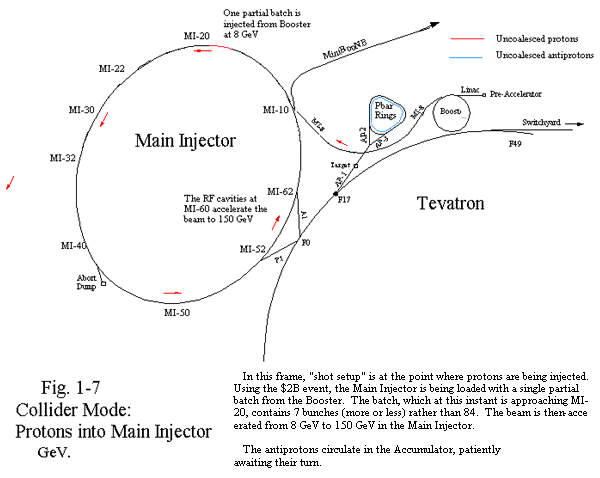
- At flattop, the bunches get coalesced, that is they are pushed together to form one narrow, high intensity bunch.
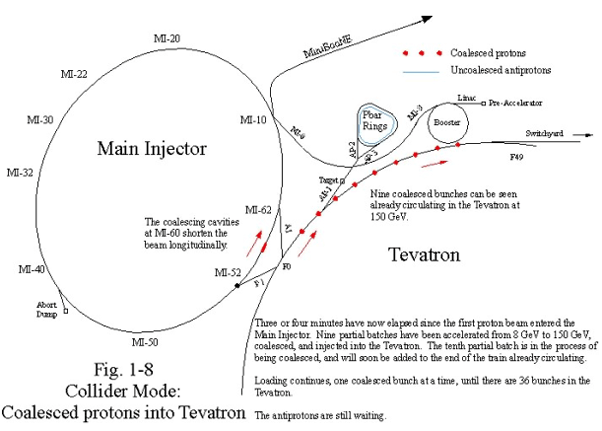
- MI injects the coalesced bunch into the Tevatron in a single turn and continues to do so until it has transferred 36 coalesced proton bunches in the Tevatron.
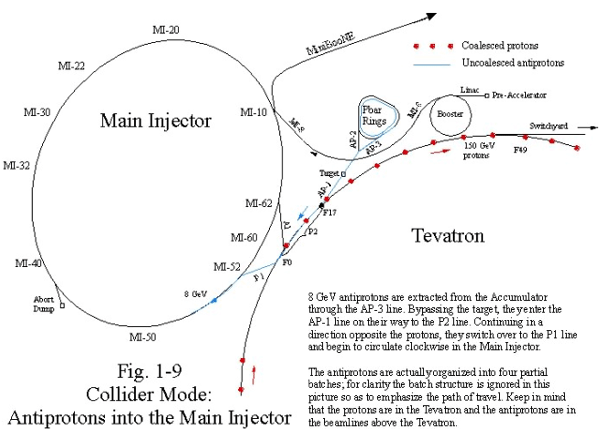
- The 8 GeV antiprotons created from the production target have been circulating in the Antiproton Source's Accumulator. The Accumulator RF systems create four groups of antiprotons that leave the Accumulator by the AP-3 and AP-1 lines, and through the P2 line at F17. They enter the Main Injector from the P1 line and circulate clockwise, which was the opposite direction that the protons took.
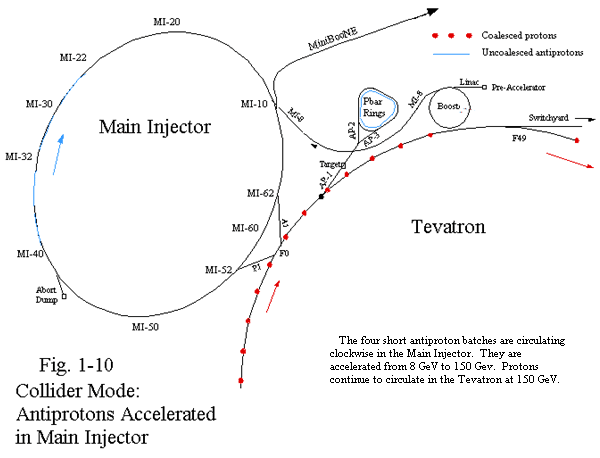
- The Main Injector coalesces the four antiproton groups and then accelerates them to 150 GeV.
- MI sends the four coalesced bunches of antiprotons through the A1 line to the Tevatron at F0. (Notice the gap in the string of proton bunches that allows room for the antiprotons.) The antiprotons travel counterclockwise in the Tevatron, which is opposite the direction of the protons. This process repeats until there are 36 coalesced bunches of antiprotons and protons circulating in the Tevatron at 150 GeV.
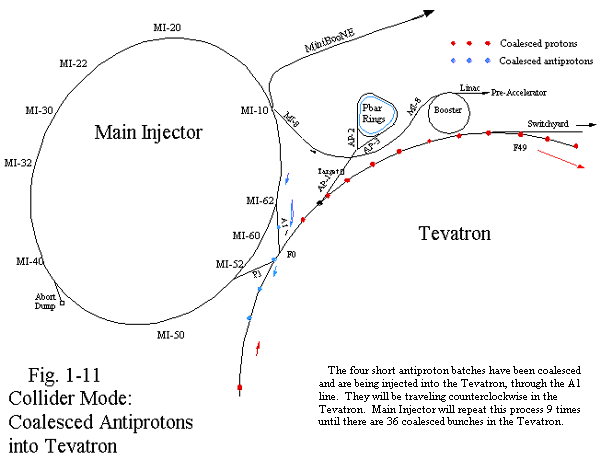
- After the Tevatron ramps the coalesced bunches to an energy of near one TeV and the two particle detectors (the Collider Detector at Fermilab - CDF, and D-Zero - D0) begin taking data, the Tevatron becomes a storage ring and a "store" has been established. Now the Main Injector returns to stacking and begins preparing for the next store.
As you can see, it is very important that the coalesced bunches be in the right place at the right time with respect to each other. This is accomplished by a technique called cogging. Think of the huge gear teeth of an old town clock that must mesh; you don't want a tooth coming down on to another tooth. Cogging makes sure that there's an empty spot for each bunch to occupy. Some cogging takes place in Main Injector and some occurs in the Tevatron.
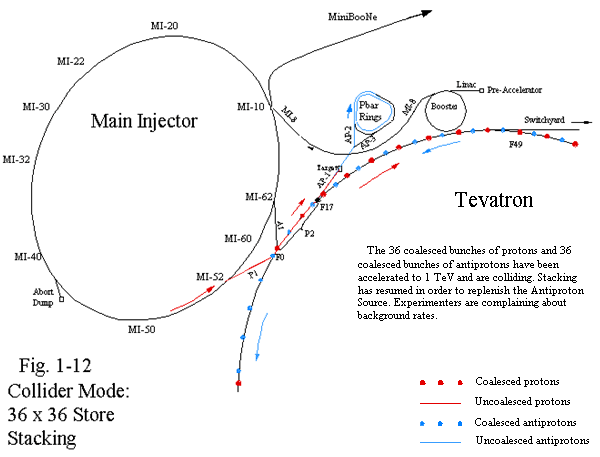
Role of the Recycler
The purpose of the Recycler is to store excess antiprotons. The number of antiprotons available has always been an important limiting factor in producing the high luminosities desired for stores in the Tevatron. Antiprotons are difficult and time-consuming to produce, and difficult to store because large numbers of antiprotons tend to develop instabilities.
The Recycler stores antiprotons from the Antiproton Source. The ring is located directly above the Main Injector ring. The Main Injector transfers antiprotons from the Accumulator to the Recycler. The antiprotons arrive from the Accumulator in the same way as they would during a shot, except that they aren't accelerated. The Recycler has its own RF system to facilitate transfers to and from the Main Injector. It also has its own cooling systems. Cooling, in this sense, means reducing the energy of the particles. When needed during a shot, the Recycler sends its antiprotons to the Main Injector. The Main Injector can transfer Recycler antiprotons and Pbar antiprotons and any order desired to the TeV.
Mixed Modes
There are two mixed modes of operations. The first mode sends beam to the Antiproton Source and to Switchyard, and the second mode sends beam to NuMI and Switchyard.
Accelerator Update Archive
More Information
For Tevatron luminosity charts and the current status of Fermilab's
accelerators and detectors (live!), please go to Fermilab Now
Comments and Suggestions
What do you think about the Accelerator Updates? Please send comments and suggestions to: accelupdates@fnal.gov.
|










